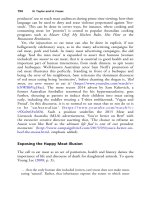The palgrave international handbook of a 455
Bạn đang xem bản rút gọn của tài liệu. Xem và tải ngay bản đầy đủ của tài liệu tại đây (30.18 KB, 1 trang )
Legal and Illegal Theriocide of Trafficked Animals
457
The International Pet Trade
The transnational trafficking of pets is, together with habitat loss, a major
threat to many species and is also known to have caused species extinction.
This is the situation whether animals are trafficked illegally or legally:
The legality of trade [of animals] does not guarantee its sustainability. By
default, trade is legal unless a motion is successfully brought before CITES
to demonstrate negative impacts. Therefore one can assume that there is legal
trade that is damaging because of outdated conservation assessments or lack of
motivation to bring the case before CITES (Busch et al. 2014, p. 673).
Reptiles and birds are the species most trafficked for the pet market and
consequently the species that are most often seized in the EU and beyond
elsewhere (van Uhm 2015). Parrots, of which millions have been trafficked in
recent decades (Tella and Hiraldo 2014) are of particular concern, together
with many of the reptile species that are trafficked which also are threatened
with extinction (Natush and Lyons 2012). According to interviews with
reptile keepers, reptiles provide great sources for fascination and are kept
also as collector items (Sollund 2013a).
van Uhm (2015) states that seizures of live animal species in the illegal wildlife
trade in the EU consist mainly of live reptiles (tortoises), followed by birds
(parrots) and incidentally mammals (primates). An overview of major international seizures within the EU in 2013 revealed that 1,570 live reptiles were seized
(TRAFFIC 2015). EU TWIX6 seizures show that more than 30,000 live reptiles
were confiscated in 2001–2010 in the EU (van Uhm 2015). Between 2000 and
2003, the EU imported 2.8 million wild CITES-approved birds (FAO 2011).
Reptiles are thus highly sought after as pets (or collector items) of whom
many are trafficked from South East Asia, especially Indonesia, due to its
biodiversity and lack of illegal wildlife trade (IWT) law enforcement (Lyons
and Natush 2011). According to Lyons and Natush (2011), the pet trade in
reptiles threatens many species that are suffering from drastic decline, among
them tortoises and freshwater turtles. While reptiles trafficked to Norway may
be purchased at Terraristika Hamm in Germany, an international reptile expo
notorious for selling wild-caught reptiles, and reptile owners in Norway claim
even reptiles sold in zoo shops in Denmark and Sweden appear to be wild
caught (Sollund 2013a), their place of origin is hard to determine.
6
European Union Trade in Wildlife Information eXchange database. />









